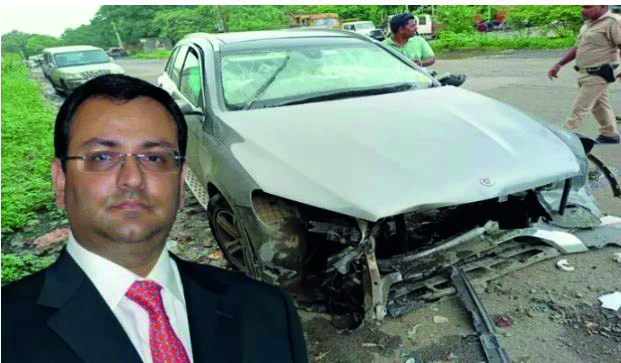CARELESS: It is deadly offense not to wear your seat belt which is often linked to the airbag in high end cars. It is estimated that 90% of Indian drivers and passengers do not wear seat belts when in the back seat of a car
By Opinida staff
The failure to wear the seat belt in the back seat was responsible for the death of Cyrus Mistry and his friend Jihangir Pandole. The lady Ananhita Pandole who was driving the car at the speed of 130/140 km when she hit a railing of a bridge.
On Sunday (September 4), the former Chairman of Tata Sons, Cyrus Mistry, died in a tragic road accident near Palghar in Maharashtra. The deceased businessman was en route from Ahmedabad to Mumbai when the incident took place.
Besides Mistry, one Jehangir Pandole also lost his life in the accident. According to police sources, the duo was sitting on the back seat without a seat belt. The Mercedes Benz car was being driven by Anahita Pandole while her husband Darius Pandole sat beside her.
The husband-wife duo managed to survive and are currently being treated at the hospital. Reportedly, the accident took place when their vehicle attempted to overtake another car from the wrong side. The vehicle lost control and ended up hitting a road divider on the Surya river bridge.
Given that Anahita Pandole and Darius Pandole were wearing seat belts, the frontal airbags opened in time and minimised the impact of the accident. Unfortunately, the curtain airbags did not open for Jehangir Pandole and Cyrus Mistry as they were not wearing seat belts. The Indian government has made it clear that wearing a seat belt is mandatory, even if the passenger is sitting in the rear seat of the vehicle. Rule 138(3) of the Central Motor vehicles Rules states [pdf], “It shall be ensured that the driver, and the person seated in the front seat or the persons occupying front facing rear seats, as the case may be, wear the seat belts while the vehicle is in motion.”
Media personality, Rajesh Kalra, shared a simulation video on social media which exemplified the need to wear seat belts, even while sitting in the back seat. A passenger, without a seat belt, can end up ejecting from his seat bumping his head on the roof of the car, during a collision.
At this point, it becomes imperative to understand how seat belts work. The primary objective of a seat belt is to keep the passenger tied to his seat in case of a sudden stop (change in momentum) as seen during a collision.
In its absence, the passengers are likely to eject out of their seats and hit their heads on the frontal part of the vehicle. In worst-case scenarios, they can be ejected out of their car altogether. The seat belt is made of webbed fabric, which in turn is attached to a retractor box.
One component of the belt goes over the passenger’s pelvis region into the buckle while the other part extends from the chest to the shoulder (called the 3-point belt system/ Y arrangement). The seat belt must allow for a little movement after being worn. If not tightly fitted, it will not serve its purpose during an accident.
Besides seat belt, modern-day cars make use of airbags to provide an additional layer of protection in the event of a collision. However, airbags are not a replacement for seat belts.
During an accident, the airbags inflate immediately and deflate when a passenger’s head bangs against them. If a passenger hits his head when an airbag is not completely inflated, it can cause serious head injuries. The deflation of the air bag is crucial, in the absence of which the passenger’s head will bounce back.
Air bags make use of a chemical reaction to inflate themselves in time. Until some years ago, sodium azide would be exposed to a heating element to produce sodium metal and nitrogen gas. However, modern cars used Guanidine nitrate to inflate air bags with nitrogen gas.
They give time to the passengers to slow down and bear the impact of the collision. For airbags to work, they need an accelerometer which can trigger the airbag circuit. The circuit employs a heating element that results in chemical reactions and the formation of nitrogen. Due to a rise in sudden pressure, the bag inflates in front of the passenger.
On impact, the airbag deflates through the edges. Thus, its use coupled with seat belts can save lives.
Courtesy: OpIndia
